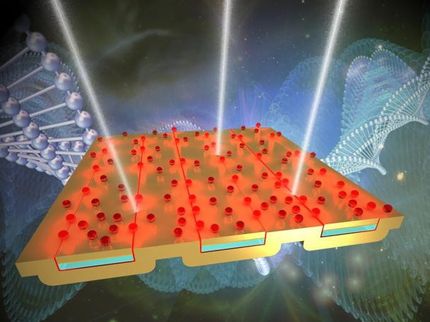"On-the-fly" spectroscopy with a diode laser and a frequency comb
MPQ scientists achieve high precision optical broadband spectroscopy by applying frequency comb technique to tunable diode lasers
The research field of optical spectroscopy has already attracted attention of generations of scientists, starting with Fraunhofer's discovery of dark lines in the sun spectrum in 1814 followed by the work of Kirchhoff and Bunsen in 1859 explaining these lines as absorption of light in atoms and molecules. Within the last decade, the invention of optical frequency combs has revolutionized the field of spectroscopy and enabled measurements with previously unattainable precision. Now, MPQ scientists (from the "Laboratory of Photonics & Quantum Measurements" lead by EPFL tenure track professor T.J. Kippenberg) developed a novel measurement scheme for broadband and fast measurements of optical spectra utilizing the accuracy of an optical frequency comb and transferring it to an easy-to-use tunable diode laser.
These tunable diode lasers can be swept in frequency (i.e. the "color" of the laser can be changed) to measure the spectral response of anything of interest, for example light absorption in gases but also the response of photonic elements in the growing field of nano-photonics. However, sweeping the frequency of a tunable diode laser alone does not allow for precise spectroscopic measurements, unless the instantaneous frequency of the diode laser at a certain time is known precisely. Here, the new measurement scheme comes into play, enabling an "on-the-fly" calibration of the sweeping diode laser using an optical fiber laser based frequency comb. The achieved precision of the spectroscopic measurement is better than 1 MHz (note that the frequency of the laser light is around 200 THz, corresponding to a relative accuracy of 5x10 to the -9).
As a first application, the newly developed spectroscopy scheme has been used by MPQ scientists Pascal Del'Haye and Dr. Arcizet to obtain absorption spectra of on-chip monolithic optical microresonators made of fused silica (so called microtoroids). These measurements allowed for the first time to analyze dispersion properties of these devices (conventional spectroscopy methods had so far failed due to the extremely narrow (sub-MHz) absorption lines of the microresonators). Numerical simulations as well as the experimental results show that the mode structure of microtoroids is extremely uniform, i.e. the optical modes that are supported by the device are nearly spaced equidistant. This surprising result is a consequence of the spatial shape of the optical modes within the resonator (leading to "red" modes at low frequencies being more confined inside the resonator than "blue" modes at high frequencies) that is partly compensated by a different material dispersion for different light frequencies (here, the "red" modes are travelling slower, i.e. the resonator seems to be larger for the "red" modes). "The small total dispersion of microtoroids makes them a well suited device for applications in microphotonics as well as for frequency comb generation via nonlinear optical frequency conversion", states Prof. Tobias Kippenberg. A patent of the new technique has been filed together with Max Planck Innovation.
Original publication: P. Del'Haye, O. Arcizet, M. L. Gorodetsky, R. Holzwarth & T. J. Kippenberg; "Frequency comb assisted diode laser spectroscopy for measurement of microcavity dispersion"; Nature Photonics, Advance Online Publication, August 2009
See the theme worlds for related content
Topic World Spectroscopy
Investigation with spectroscopy gives us unique insights into the composition and structure of materials. From UV-Vis spectroscopy to infrared and Raman spectroscopy to fluorescence and atomic absorption spectroscopy, spectroscopy offers us a wide range of analytical techniques to precisely characterize substances. Immerse yourself in the fascinating world of spectroscopy!

Topic World Spectroscopy
Investigation with spectroscopy gives us unique insights into the composition and structure of materials. From UV-Vis spectroscopy to infrared and Raman spectroscopy to fluorescence and atomic absorption spectroscopy, spectroscopy offers us a wide range of analytical techniques to precisely characterize substances. Immerse yourself in the fascinating world of spectroscopy!


























































